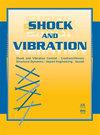A New Methodology for Optimal Design of Hybrid Vibration Control Systems (MR + TMD) for Buildings under Seismic Excitation
IF 1.2
4区 工程技术
Q3 ACOUSTICS
引用次数: 0
Abstract
This study proposes a new methodology, based on the optimization procedure by a metaheuristic algorithm, for designing a hybrid vibration control system to mitigate the dynamic response of buildings under nonstationary artificial earthquakes (NSAEs). For illustration purposes, a 10-story shear building is studied. The hybrid control system involves the use of an MR damper (MR) and a tuned mass damper (TMD) located in different places of the structure. To describe the behavior of the MR, the modified Bouc–Wen model (MBW) was used. To calculate the damping force of the MR, the clipped optimal control associated with linear quadratic regulator (LQR), CO-LQR, was considered. The optimization was performed using the whale optimization algorithm (WOA) and seismic load generated by the Kanai–Tajimi spectrum. Different control scenarios were evaluated: MR-OFF, MR-ON, CO-LQR, STMD, and CO-LQR (MR + TMD) to determine the best control scenario that can effectively control the structure. Overall, the optimized hybrid control scenario (MR + TMD) was the only one able to adapt all story drifts to the control criterion of the consulted normative. Then, CO-LQR (MR + TMD), designed via the methodology proposed in this work, proved to be the best alternative to control the seismic response of this building.混合振动控制系统优化设计的一种新方法 + TMD)
本文提出了一种基于元启发式算法优化过程的混合振动控制系统设计方法,以减轻建筑物在非平稳人工地震(NSAEs)下的动力响应。为了说明,本文研究了一座10层剪力建筑。混合控制系统包括在结构的不同位置使用磁流变阻尼器(MR)和调谐质量阻尼器(TMD)。为了描述磁流变的行为,采用了改进的Bouc-Wen模型(MBW)。为了计算磁振器的阻尼力,考虑了带线性二次型调节器(LQR)的夹片最优控制CO-LQR。利用鲸鱼优化算法(WOA)和Kanai-Tajimi谱产生的地震荷载进行优化。评估不同的控制方案:MR- off、MR- on、CO-LQR、STMD和CO-LQR (MR + TMD),以确定能有效控制结构的最佳控制方案。总体而言,优化的混合控制方案(MR + TMD)是唯一能够使所有故事漂移适应参考规范的控制标准的方案。然后,通过本工作中提出的方法设计的CO-LQR (MR + TMD)被证明是控制该建筑地震反应的最佳选择。
本文章由计算机程序翻译,如有差异,请以英文原文为准。
求助全文
约1分钟内获得全文
求助全文
来源期刊

Shock and Vibration
物理-工程:机械
CiteScore
3.40
自引率
6.20%
发文量
384
审稿时长
3 months
期刊介绍:
Shock and Vibration publishes papers on all aspects of shock and vibration, especially in relation to civil, mechanical and aerospace engineering applications, as well as transport, materials and geoscience. Papers may be theoretical or experimental, and either fundamental or highly applied.
 求助内容:
求助内容: 应助结果提醒方式:
应助结果提醒方式:


